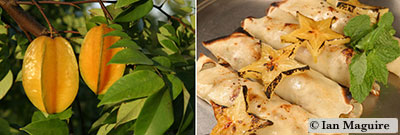Carambola
Nutritious and eye-catching, new cultivars of this tropical fruit are even sweeter.
Characteristics
Also called carambola, star fruit (Averrhoa carambola L.) is native to Southeast Asia but has been grown in Florida for over 100 years. Older varieties of carambola tend to be quite tart; new, sweeter cultivars have been selected thanks to seeds and vegetative introductions from Thailand, Taiwan, and Malaysia.
Carambola trees are evergreen, although when grown in cooler locales they can lose some or all of their leaves during late winter and early spring. The star fruit tree will grow to heights of 20 to 30 feet tall if not pruned. These trees generally have a multi-branched bushy, rounded canopy.
Fruits are fleshy, with a yellow, waxy edible peel; the seeds are edible as well. When fully ripened, star fruit is crisp and sweet, and a good source of vitamins C and A, phosphorus, and potassium. Slices of the fruit look like stars—hence the celestial name.
The flowers that precede fruiting are pink to lavender colored. Seeds lose viability within a few days of removal from the fruit, so if you’re hoping to use them to grow more trees, be sure to get them growing right away. However, trees started from your own tree’s seeds may end up tart and could take years before they are productive. Buying named cultivars and grafted trees from nurserymen is recommended to be sure you are growing the sweetest fruits.
Planting and Care
You can grow star fruit in South Florida and warmer southeastern and southwestern counties. However, this plant is not tolerant of salt or high pH soils—star fruit is prone to chlorosis (yellowing of plant tissue) in alkaline or limestone soils. Plant your star fruit in full sun, away from other trees and buildings, structures, and power lines. Along with warm temperatures, this plant needs well-drained soil, improved fertilization, and protection from the wind. It may also need supplemental irrigation as carambola is not drought-tolerant. Harvest your star fruit from June to February; fruit are sweetest when they are allowed to fully ripen on the tree. Some cultivars of star fruit can produce two to three crops per year.
A Note of Caution
It should be noted that people who have been diagnosed with kidney disease should not eat star fruit unless their doctor says that it is safe for them to eat. This fruit may contain enough oxalic acid to cause kidney issues.


